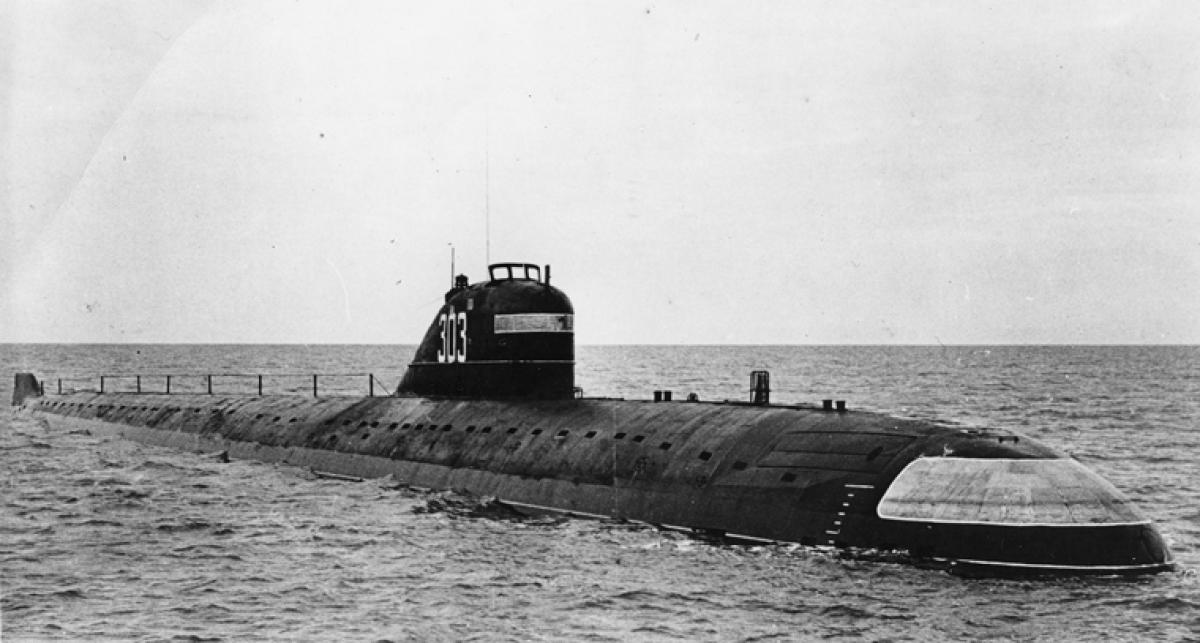The T-15 was one of the most ambitious submarine weapon projects ever undertaken. The torpedo was intended to carry a thermonuclear (hydrogen) warhead a distance of up to 16 nautical miles. The T-15, with a diameter of more than five feet and a length of approximately 77 feet, was expected to weigh some 40 tons. A battery-powered electric motor would propel it at an undersea speed of about 30 knots. A submarine carrying a T-15 would surface at night off the enemy’s coast to determine the craft’s precise location, using radar to identify coastal land features.
Obviously, a new submarine would have to be designed to carry the big torpedo—one torpedo per submarine. The long, submerged distances that the submarine would have to transit to reach its targets demanded nuclear propulsion. In 1947, Boris M. Malinin, the dean of Soviet submarine designers in the early postwar years, addressed the concept of nuclear-propelled submarines:
A submarine must become an underwater boat in the full meaning of the word. This means that it must spend the greater and overwhelming part of its life under water, appearing on the surface of the sea only in exceptional circumstances. . . . The submarine will remain the most formidable weapon in naval warfare. . . . If . . . it is considered that the appearance of super powerful engines, powered by intranuclear (atomic) energy is probable in the near future—then the correct selection of the direction in which the evolution must go is . . . the basic condition for the success of submarines.1
On 9 September 1952, at the direction of Soviet leader Josef Stalin, the Council of Ministers adopted a resolution for the development of a nuclear submarine, which Stalin formally approved three days later. The submarine would carry a single T-15 torpedo, with two standard, 21-inch torpedo tubes, without reloads, for self defense. The T-15 torpedo would be “self-launched,” i.e., it would swim out of the tube. This required the torpedo tube to be longer than it would otherwise, but the scheme was considerably simpler than conventional launch systems and would save several tons of weight.
The design of the submarine—designated Project 627—began right away at the Research Institute of Chemical Machine Building, which would design the nuclear reactor for the boat. The following March, special design bureau SKB-143 was reorganized under Captain 1st Rank Vladimir N. Peregudov and given responsibility for the design of the submarine.2 Peregudov was assigned broad authority for acquiring personnel and facilities and was provided an aircraft for rapid transportation. An engineering specialist, he was a protégé of Malinin and had participated in designing diesel-electric subs in the 1930s.
Peregudov was informed of the nuclear submarine project and given his assignment in the fall of 1952 at a meeting in the Kremlin. Several hundred engineers and supporting staff from other institutes and bureaus were assigned to SKB-143. Few Navy personnel were to work the project, with Peregudov being one of the exceptions.
Malinin and Peregudov had discussed the potential of nuclear propulsion for submarines in 1949. As chief designer for Project 627, Peregudov was responsible to the Ministry of Medium Machine Building, which was in charge of all nuclear programs. Navy leadership was not provided with information on the project because it was considered too highly classified. N. A. Dollazhal was placed in charge of reactor design, while G. A. Gasanov would design and build the steam generators.
Dollazhal had never even seen a submarine; Peregudov knew nothing of nuclear physics; and their ability to talk to experts was severely restricted by security rules. The participants were warned continually not to discuss their work—even with their own colleagues—unless it was absolutely necessary. Vladimir Barantsev of SKB-143 recalled:
I was never officially told what we were designing. I had to guess it myself. I didn’t know what we were engaged in. The word reactor was never pronounced out loud. It was called a crystallizer not a reactor and it took me about three or even four months to understand what kind of submarine we were designing. . . . When I looked at the drawings and saw the dimensions of the [propeller] shaft I guessed everything but I was advised not to discuss it with others.3
A prototype of the pressurized-water propulsion plant was constructed on land, at Obninsk, in the same manner that the prototype plant of the USS Nautilus (SSN-571) was installed at Arco, Idaho.4 The Obninsk facility, some 60 miles southwest of Moscow, consisted of three compartments with a single submarine reactor, turbine, and associated heat exchangers and pumps, with one propeller shaft and other equipment. The Obninsk submarine reactor became critical on 8 March 1956.
The Project 627 submarine—initially named K-3—featured a new hull design. Whereas the Nautilus had a modified German Type XXI configuration, which also was being used in new U.S. diesel-electric boats, Peregudov designed the submarine with a modified teardrop or torpedo shape, based in part on the U.S. research submarine USS Albacore (AGSS-569). “We had details of the Albacore from magazine photos,” according to Russian engineers.5 The K-3’s long, sleek lines of the outer hull were melded into a low, streamlined sail structure—what became known as the “limousine” or “cockpit” shape. The classic double-hull configuration was retained, providing a reserve buoyancy of about 30 percent compared to 16 percent for the Nautilus. Inside, the Project 627 design had nine compartments: torpedo (bow), battery/crew, control, officers’ berthing/mess, reactor, turbine, two machinery compartments, and the stern compartment. The submarine’s pressure hull was fabricated of the new AK-25 high-tensile steel, which provided Project 627’s test depth of 1,000 feet (compared to only 700 feet for the Nautilus).
Amidships, the reactor compartment contained two VM-A reactors, each providing approximately 70 megawatts of thermal power. Two reactors and duplication of machinery were deemed necessary for reliability as Soviet designers and engineers feared equipment faults as well as mistakes by crewmen, but the submarine could operate safely with only one reactor online. Twin steam turbines were to generate a total of 35,000 horsepower (almost three times the power of the Nautilus). The submarine’s reactor was to produce the hydrogen isotope tritium, which could be used in thermonuclear warheads in the T-15, a very unusual feature.
SKB-143 designers worked day and night to complete the design of the strategic attack submarine, finishing in 1954. Construction began on 24 September 1955 at the Molotovsk shipyard (present-day Severodvinsk) with the formal—and highly secret—keel laying of the K-3.
The Commander-in-Chief of the Navy, Fleet Admiral Nikolai Kuznetsov, was aware that a nuclear-propelled submarine was being developed, but so great was the secrecy of nuclear programs in the USSR that he was given no information about its giant nuclear torpedo. When the design was completed—after Stalin’s death in March 1953—Kuznetsov was briefed on the project in July 1954 and reportedly declared, “I don’t need that kind of boat.”6
A Soviet Navy panel reviewed the project and recommended that the submarine be converted to a torpedo-attack boat for use against enemy ships, a recommendation Kuznetsov supported. All work on the giant T-15 torpedo stopped. In 1955, the requirements for Project 627 were revised, with the submarine now to be armed with conventional high-explosive and nuclear 21-inch torpedoes. The forward section of the submarine was redesigned with eight torpedo tubes, and the submarine carried a total of 20 torpedoes.
The K-3 was launched on 9 August 1957. She got under way for the first time at 1030 on 3 July 1958, propelled by her electric motors powered by diesel generators. Her reactors were set at minimum power. The following day propulsion was shifted to her two nuclear reactors and twin steam turbines.
Given the U.S.-NATO codename “November” and later named Leninskiy Komsomol, the K-3 was the first of the large number of nuclear-propelled submarines built by the Soviet Union and Russia—more than the rest of the world’s navies combined. And she carried standard, 21-inch torpedoes, not the big, “city-busting” torpedo that was to have armed Soviet strategic attack submarines.
1. CAPT-LT Yu. Stvolinsky (Ret), “The Beginning,” Leningradskaya Pravda, 15 March 1979, 3. The original Malinin manuscript is in the Central Naval Museum in St. Petersburg.
2. At the time of his appointment Peregudov was deputy director of the Shipbuilding Ministry’s Central Scientific Research Institute No. 45. Like many Soviet engineers, in the late 1930s Peregudov was imprisoned, beaten and tortured. In 1952 he was assistant director of scientific research institute (Naucho-Issledovatel’skii Institut ) NII-45, now the A.N. Krylov Research Institute (for shipbuilding). Peregudov was already seriously ill when named chief designer of Project 627; he died in 1967.
3. V.I. Barantsev, Malachite design bureau, discussions with N. Polmar, St. Petersburg, 3 October 1994 and 6 December 1996; direct quotation from Roy Davies, Nautilus: The Story of Man Under the Sea (London: BBC Books, 1995), 19. The book accompanied the BBC television series “Nautilus.”
4. The Obninsk research center was the location of the world’s first atomic power station, put into operation in 1954. It was capable of producing a modest five magawatts of power.
5. V. Semyonov and Rubin design bureau engineers in discussion with N. Polmar, St. Petersburg, 5 December 1996.
6. S. Bystrov, “A Reactor for Submarines,” Krasnaya Zvezdochka (21 October 1989).




